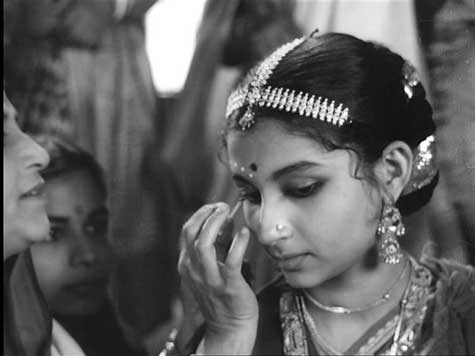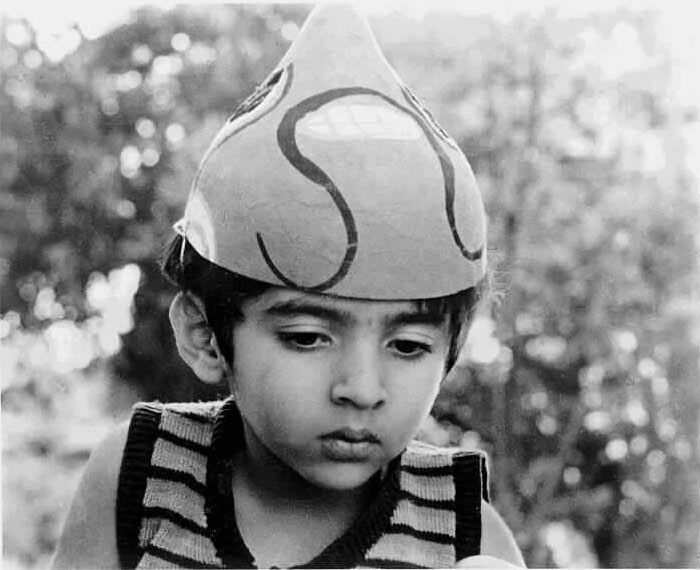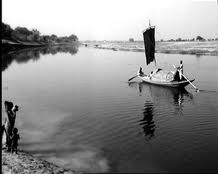Apur Sansar (1959)
This is a collection of articles archived for the excellence of their content. Readers can send additional information, corrections, photographs and even Readers will be able to edit existing articles and post new articles |
]
Contents |
Apur Sansar (The World of Apu) from SatyajitRay.org
1959, India. 106 min, B/W, In Bengali with subtitles.
Credits
Producer: Satyajit Ray Productions
Screenplay & Direction: Satyajit Ray; based on the novel "Aparajita" by Bibhutibhushan Banerjee.
Cinematography: Subrata Mitra
Editing: Dulal Dutta
Art Direction: Bansi Chandragupta
Sound: Durgadas Mitra
Music: Pandit Ravi Shankar
U.S. Distributor: Merchant-Ivory/Sony Pictures Classics
Cast
Character: Performer
Apu, Apurba Kumar Roy: Soumitra Chatterjee
Aparna: Sharmila Tagore
Pulu: Swapan Mukherjee
Kajal: Alok Chakravarty
Pulu's wife: Sefalika Devi
Sasinarayan: Dhiresh Majumdar
Landlord: Dhiren Ghosh
Summary
Apur Sansar is the third and final film of the The Apu Trilogy. Apu (Soumitra Chatterjee) is now a graduate and without a job. He lives in a rented room next to a busy railway yard. He finds himself among a large population of the unemployed youth in the city. To pay his rent, he has to sell his books. The job search turns out to be an amusing and a tormenting experience.
Unfazed, He is writing a novel based on his life, which he hopes will make him famous. His life takes a turn, however, when he meets his old friend Pulu. He coerces Apu to travel to his ancestral village to attend the wedding of his cousin, Aparna (Sharmila Tagore). On the boat ride to the village Pulu reads Apu's manuscript and appreciates the work.
On the day of the wedding, the bridegroom turns out to be mentally deranged and the wedding is canceled. The villagers believe if she is not married before the auspicious hour passes, the ill-fated bride can never be married again. Apu primarily of out sympathy for the bride and some convincing by Pulu, agrees to be the substitute groom. He has not even seen her yet.
The marriage takes place and Apu and his young wife return to his Calcutta apartment. Soon, a warm and caring relationship develops. Apu willingly takes up the clerical job that he has so far avoided. The marital bliss, however, is short lived.
Pregnant, she goes to her parents' place and dies during the childbirth. Apu's world shatters as he receives the news of Aparna's death. Sunken in grief, he refuses to even see the child whom he holds responsible for his wife's death. He leaves Calcutta to lead the life of a wanderer.
About five years pass, Apu's friend Pulu, who had been abroad, is shocked to find the child growing wild and not cared for. Pulu goes in search of Apu and requests to take responsibility for his son, Kajal.
Reluctantly, Apu comes back to the village. On seeing Kajal, Apu is overwhelmed by affection. Now it is the child who refuses to accept him as his father. Apu wins over the little boy. The child accepts him as a friend, though not as a father yet. United, they leave for Calcutta to make a new beginning.
Comments
In Apur Sansar, Ray introduced two new actors who would become regulars for Ray films, Soumitra Chatterjee played Apu and Sharmila Tagore played his young wife Aparna. By way of experience, Soumitra Chatterjee was a radio announcer and had only played a small role in a Bengali stage production and Sharmila was just a fourteen-year-old with no previous acting experience. As the shooting began, Ray had to shout instructions to Sharmila during the takes. None of this, however, is reflected on the screen. Both tuned out be quick learners and gave memorable performances.
Soumitra Chatterjee played many roles in Ray's later films (15 films) and became the most sought after actor in Bengali cinema. Sharmila Tagore went on to become a very successful actress in Bombay's Hindi films. She returned to work in later films of Ray such as Devi, Nayak, Aranyer Din Ratri and Seemabaddha.
The sequences of Apu and Aparna in Calcutta, are the most striking and cinematic part of the film. In the beginning of the film, we have seen Apu's room as a bachelor's apartment. Now there are two pillows on the bed, curtains on the windows and a plant on the windowsill. The apartment has a clear touch of a woman's presence. Apu awakes and finds a hairpin lying between the pillows. Still lying in the bed, Apu observes Aparna with a fixed gaze as she goes about doing the household chores. Aparna asks, "Haven't you seen your wife before?" Apu smiles, plays with the hairpin and picks up his pack of cigarettes. As he opens the pack, he finds a note from Aparna inside, "You promised not to smoke more than one after meals!" Apu smiles again and puts the pack away. With simple actions and situation, the intimacy is established. After seeing the film, Renoir is said to have remarked that intimacy had been suggested without showing even a single embrace.
Later in the film, Aparna is leaving to be at her parents' place for childbirth. She lights a match to light the cigarette that Apu has put in his mouth. The flame brings a glow to her face. Apu asks, "what is in your eyes?" "Kajal" (mascara / kohl), she replies with a mischief. Lather, the son born to her would also be named "Kajal".Aparna dies off-screen. Her brother brings the bad news. This is a lyrical and inspired sequence. Apu is working and carrying Aparna's letter in his pocket. Towards the end of the day, he can no longer wait to read the letter. A touching letter is heard in Aparna's voice. Apu in interrupted by a fellow clerk.
He takes out the letter again to continue reading on his way home in a crowded tram. A passenger peeps over his shoulders to read, forcing him to put the letter back again. He finishes reading the letter during the walk home by the railway yard. With Aparna's voice still in his mind, he sees her brother waiting for him. Apu's smile vanishes; he senses something wrong. As Aparna's brother conveys the news of her death, Apu looses control. His world is shattered. He slaps the messenger, staggers to his room and collapses on the bed.
What follows is a long, wonderful and speechless sequence; dealing with Apu's grief. Satyajit Ray describes in 'My Years with Apu' - "The grief-stricken Apu lies in bed for days. ... At one point, however, Apu rises from the bed. He hasn't got over his grief. He stands leaning against the wall. The camera moves to the shaving mirror to show his blank look. Off screen is heard the screech of a train whistle. Apu reacts. The camera moves closer to his face. His eyes have a new look. The screen turns white. There is the sound of a rushing train and smoke rises from the bottom of the screen in what is now established as sky. The camera moves back to show Apu in close up, obviously standing by the railway track. The smoke approaches, then we see the engine. Apu, his face still a blank, slowly leans forward, preparing to throw himself before the train. Suddenly, a screech is heard. It is the cry of a pig, which has been run over by the train. Apu's spell is broken and with it his determination to take his own life.
In he final moments of the film, Kajal has rejected Apu. When Apu's father-in-law is about to strike Kajal with a stick because he has refused to leave with Apu, Apu rescues Kajal instinctively. A hint of trust begins to develop. Apu starts to walk away as he has given up hope of earning Kajal's love. But Kajal has now decided to trust Apu. He runs away to join Apu as grandfather watches from a distance. Apu sweeps up Kajal in his arms. Both leave for a new life together with Apu carrying Kajal on his shoulders. Apur Sansar was a big box office success both at home and abroad.
What others say
"Rich and contemplative, and a great, convincing affirmation." - Pauline Kael
Jeff Vorndam on Apur Sansar
The World of Apu
a.k.a. Apur Sansar
The World of Apu Bengali language. India, 1959. Unrated. 106 minutes.
By Jeff Vorndam
Grade: A Review by Jeff Vorndam
The World of Apu is my introduction to the films of Satyajit Ray, and if its power and humanity is indicative of the quality of his other films then I am overjoyed to make their acquaintance. In The World of Apu I was in the hands of a master filmmaker from start to finish. The film is the third installment of the widely regarded Apu Trilogy (preceded by Pather Panchali and Aparajito). As a stand-alone film, The World of Apu still works remarkably, despite references to events that are not so much acknowledged as felt in the character of the movie's protagonist. If you don't want key events from the first two films "spoiled" I suggest watching those films first before reading further or seeing The World of Apu.
Apu (Soumitra Chatterjee) is a young man who has recently graduated from college. He lives alone in a small apartment, intermittently working on a novel. Apu doesn't have a job or a family, and his landlord, who has been very understanding in allowing him to be three months late with the rent, can hold out no longer. The poverty of Calcutta lingers on the fringes of each scene, never dominating the story but always present. Ray takes his time with these early scenes, establishing the character of Apu in a few wordless poetic passages that house a great deal of detail. His trusting and open nature is depicted in a scene where he soaks up the summer rain with a broad grin, and his frustration at not finding work is shown in a shot of Apu in dejected repose, playing his flute. Apu thinks he has the makings of a decent novel on his hands and that working as a clerk is beneath him, but his friend Pulu (Alok Chakravarty) chastises him and tells him that he still lacks the life experience to know what he's writing about.
Pulu convinces Apu to come with him for a few days to East Bengal where a relative of his is getting married. The wedding goes awry when the bridegroom develops a sudden mental illness and leaves the bride in the lurch. The bride's family panics–it is their belief that her life will be cursed if she does not get married to someone on that day. In steps Apu, reluctantly, almost as if he has nothing better to do (though he views it as an act of nobility to save the girl). The plot at this point may sound like some wacky comedy, but it's handled with more gravity than levity. The ceremony is beautifully portrayed as a meaningful cross-pollination of souls. The intensely wary yet wondrous gazes between Apu and his new wife Aparna (Sharmila Tagore) convey their anxiety as well as hint that deep down they are not displeased at the turn of events.
When Apu returns with Aparna to Calcutta and his humble abode, the film enters its second and most lovingly rendered act. The scenes in which Apu and Aparna feel each other out as human beings and man and wife are utterly convincing and breathtaking in their simplicity and lyricism. Their progression from awkwardness to quiet closeness is almost entirely rendered visually. An edit shows a lapse of time with a shot of a window adding a feminine curtain. Apu and Aparna play possum in the early morning, stealing glances at each other when the other's eyes are closed. When Aparna gets up to do so some cleaning, she playfully raps the still sleeping Apu on the backside.
Aparna assuages Apu's worries that he cannot financially support her when she confides to him that she'd be happy if he quit the job he does have, because it would mean he would be home more often. She eagerly learns to read, which Apu teaches her. I should mention at this point that the actress playing Aparna, Sharmila Tagore, is surpassingly beautiful, and Ray photographs her adoringly. When she leaves by train to visit her parents while she gives birth to their child, Ray wallops us with a stunning close-up of Aparna. The unexpected hugeness of the picture, and the feelings we've grown to associate with her character, converge with overwhelming force to finalize the bond between Apu and Aparna. The shock and loss are all the greater then, when we learn that Aparna has died giving birth to their son Kajal. The news devastates Apu and he reacts angrily, striking the messenger. He then turns his anger toward his child, whom he has not met. Blaming Kajal for killing his beloved, Apu refuses to see the boy and instead leaves Calcutta to wander the land.
The third act of the movie consists of Apu's wanderings and his eventual epiphany. It's not easily arrived, and for a long time I wondered if Apu would ever come back. Apu walls himself in a cell of grief. He cannot find peace in a life that has repeatedly knocked him down. Hope and life spring from setback, though. When Pulu comes to convince Apu that he needs to see his son, now four years old, Apu finally relents. The closing scenes of the film avoid sentimentality and cheap emotional heart-tugging with their precise observational qualities. A great deal of pain has yet to heal, and the ending is certainly more of a beginning than an ending. Ravi Shankar's musical score, which beautifully accompanies without intruding, finally comes to the forefront as Apu accepts his new life once again.
Ray manage to create a magical film from this familiar storyline in a way that cannot be duplicated, though it seems many after him have tried. The World of Apu has that kick, that unseen but felt dimension that translates into something more than mere dialogue and moving pictures projected on a screen. It's one of those films that makes our world seem a little larger, even as we now know a little bit more about life. I wish Ray had made more Apu films. I would like to know where Apu goes from here. Does he finally attain peace and happiness, or does it flutter away again, like it always seems to do? I hope, at least, that it lasts a little longer this time.
Review © June 2000 by AboutFilm.Com and the author.
Apur Sansar (1959): A Synopsis
Friday, December 11, 2009
Apur Sansar ( 1959 ) The World of Apu
Satyajit Ray* 110 minutes*
An impoverished Apu ( Soumitra Chatterjee ) is now somewhere in his twenties, rent dodging, job seeking, dreaming of making a living out of his literary talent, hoping to avoid a soul destroying occupation. The camera roves over the smoky, misty, noisy, crowded Calcutta-scape to the accompaniment of Ravi Shankar's perfect musical accompaniment and I could not avoid the pangs of nostalgia for a less complicated and more friendly world that seems to have passed by. How lovingly the landlord demands arrears of rent! No room for stereotypes ! Ray's world is overwhelmingly good natured ( a kind of Bangla Malgudi, to draw a far fetched comparison ). Ray was confessedly a man of the city, and his rural knowledge is acquired. He breathes poetry into whatever he touches and this final installment is a worthy conclusion, as he leaves an open future to his creations as the film concludes.
We see the family in the processes of an Indian marriage turning sour mid-way. The joyous wail of the shehnai is abruptly interrupted. The dignified and shy bride ( Sharmila Tagore) is cast into the midstream of life's cross-currents, her fortunes as uncertain as a cast of die. People who say Ray's cinema is slow don't know what they are talking about. There may not be motion of objects at velocity but the development of events which shape people's lives is always swift and the tension never slackens, hardly for a moment. In these unhurried and contemplative rhythms, he is able to encompass the extremeties of birth and death. The moments of trauma are captured imaginatively like the son hurling a big stone at his father or Apu when he hits his brother in law. This is as violent as it ever gets in the trilogy.
The concluding part of the film --the first encounter of the absconding father with his five year child-- is cinema of rare emotional sensitivity which never descends to the expected or stereotyped. Ray is able to enter the mind of children, the wonder as well as the terror and heartache, like few others. The demon-mask with which the child is introduced is an apt metaphor of the tumult within a rejected child. It is Apu the Second! One could write a great deal about this last segment, whose meticulous crafting, deserves to be put under an appreciative microscope.
See also
Pather Panchali 1955
Apur Sansar (1959)



